
The VAMPIRE crew: Will Johns, Ph.D., Jason Moore, Ph.D., and Paul Sheldon, Ph.D. (photo by Dana Johnson)
Supercomputer research costs drained by VAMPIRE
A team of Vanderbilt University and Medical Center scientists has developed a cluster of personal computers, built with off-the-shelf components, that rivals a super computer’s computational power at a fraction of the cost.
Dubbed VAMPIRE (VAnderbilt Multi-Processor Integrated Research Engine), the parallel computer will support physics and biology research projects that require huge computational ability. Parallel computers use more than one Central Processing Unit (CPU, the “brain” of the computer) at the same time to solve a single problem.
“It’s very inexpensive, especially compared to a comparable super computer, which to do essentially the same thing would cost in the millions of dollars,” said Jason Moore, Ph.D., assistant professor of Molecular Physiology and Biophysics and a member of the Vanderbilt-Ingram Cancer Center.
“We literally shopped around on the Internet and found the cheapest prices for each component, which we bought separately. Then we had a two-day get-together where we put it all together by hand. That’s how we built it for $100,000 instead of a million dollars.”
Moore is co-director of VAMPIRE, along with Paul Sheldon, Ph.D., associate professor of Physics, and Will Johns, Ph.D., assistant professor of Physics. The seed project was funded through a combination of sources, including a Medical Center Discovery Grant and funds from the individual investigators. A request for a two-year, $200,000 Discovery Grant from University Central is pending.
Housed in Academic Computing and Information Services (ACIS) in the Hill Center on the Peabody campus, VAMPIRE consists of 54 dual-processor “nodes” connected through a high-speed network. The parts are standard, so upgrades or replacements can be made easily and inexpensively, the scientists say.
The group ultimately hopes to leverage this seed project into a larger, regional system, with thousands of nodes, that will help university and medical center investigators attract additional funding from the National Science Foundation and the National Institutes of Health to carry out computationally intensive research.
VAMPIRE will be used for data-intensive research projects ranging from understanding the genetic complexity of cancer and other diseases to unraveling the mysteries behind the beginnings of the universe.
“Two of our colleagues at Brookhaven National Laboratory are basically recreating, on a small level, the universe in a very early stage when matter was not made up of individual nuclei but a soup of the constituents of nuclei,” Sheldon said. “They’ll have an enormous amount of data to search through for the markers that they really have created this state. Then they can start to understand its properties, how the Big Bang occurred and what evolved after that.”
Likewise, researchers in the field of human genetics are collecting “tons and tons” of data, and collecting more and more of it every day – without a corresponding expansion in the ability to understand that data, Moore said.
“For instance, investigators in the Cancer Center are making use of the DNA mircroarray core facility, which allows you to measure the expression of tens of thousands of genes at the same time, all from a single tissue or cell line,” Moore said. “The number of combinations of expressed genes is just astronomical, and you have to sort through them to determine which combinations are meaningful. This resource will be useful to analyze these data.”
VAMPIRE is also expected to spark interesting and fruitful collaborations across diverse disciplines like physics and biology, Sheldon said. “When you strip away the physics and the biology, it’s almost the same problem – the data look the same,” he said. He noted that his work with Moore has already led to use of genetics analysis methods to analyze physics problems.
Alan Tackett, Ph.D., is the full-time administrator of the VAMPIRE system. Other co-investigators include Walter Chazin, Ph.D., professor of Biochemistry and Ingram Professor of Cancer Research; Christopher Coffey, Ph.D., assistant professor of Preventive Medicine; Victoria Greene, Ph.D., assistant professor of Physics; Jonathan Haines, Ph.D., professor of Molecular Physiology & Biophysics; Charles Maguire, Ph.D., professor of Physics; Medford Webster, Ph.D., professor of Physics; and Scott Williams, Ph.D., associate professor of Microbiology at Meharry Medical College.













